ARM A53/A57/T760 investigated - Samsung Galaxy Note 4 Exynos Review
by Andrei Frumusanu & Ryan Smith on February 10, 2015 7:30 AM ESTGPU Performance
In the graphics department we're matching up Qualcomm's Adreno 420 versus the Mali T760MP6. The Adreno is running at 600MHz and is able to benefit from almost double the memory bandwidth at 25.6GB/s versus 13.2GB/s due to the Snapdragon's increased 128-bit memory interface. Let's look at how both compare in our overall benchmarks:

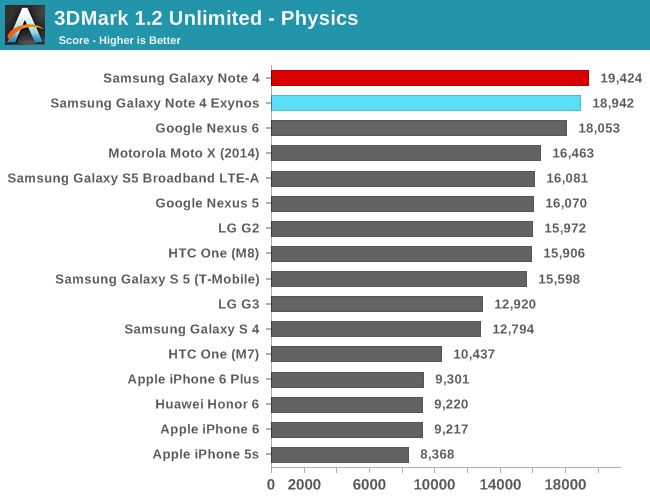
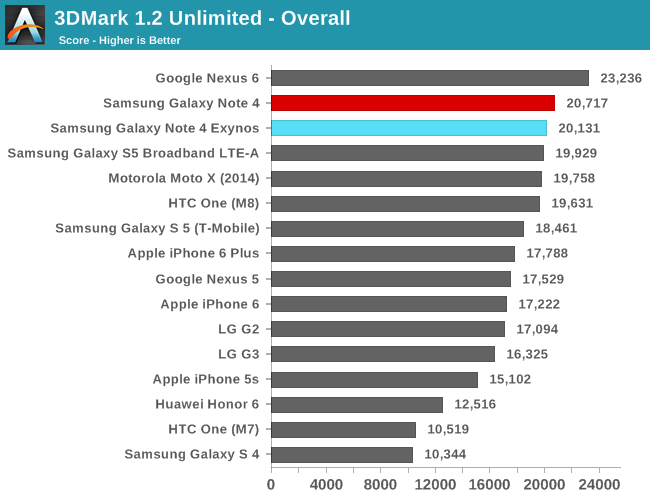
In 3DMark Unlimited the Exynos version comes just short of a few fps behind the Adreno 420. What is also surprising is that the Exynos 5433 performs much better in the physics score than I had anticipated; the same test on Huawei's SoCs limited the thread onto the little cores in the default settings giving mediocre performance results. However, it seems the A53 is performing much better and is able to match Qualcomm's offering now.
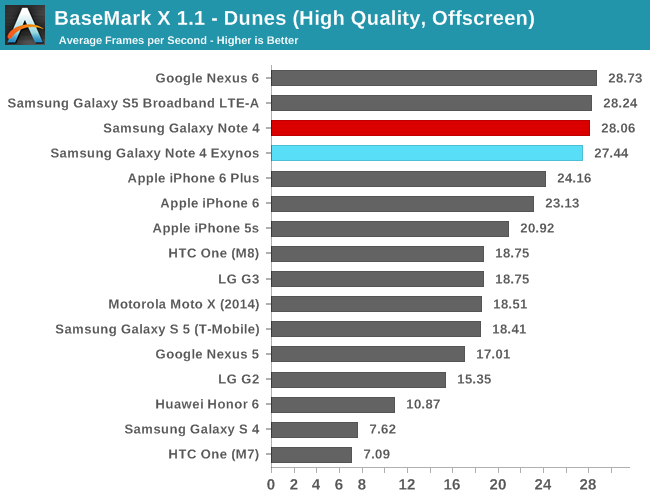
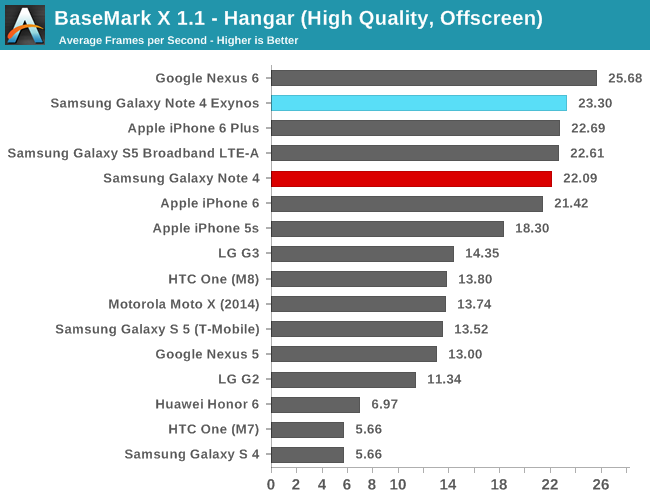
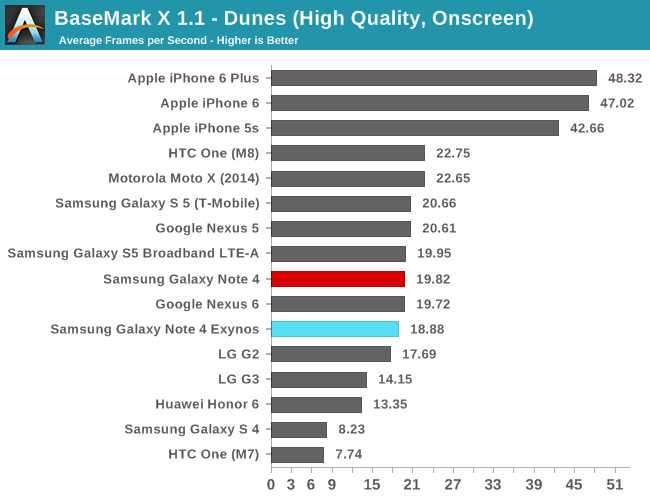

In BaseMark X 1.1, the Exynos is again neck-and-neck with the Snapdragon version. It loses by a slight margin in the Dunes benchmark while winning in the Hangar scenes by a similarly small margin. BaseMark X is again one of the benchmarks that can trigger the 700MHz state of the Mali GPU, offering higher performance at a much higher power draw depending on which scene is currently rendered on both tests.
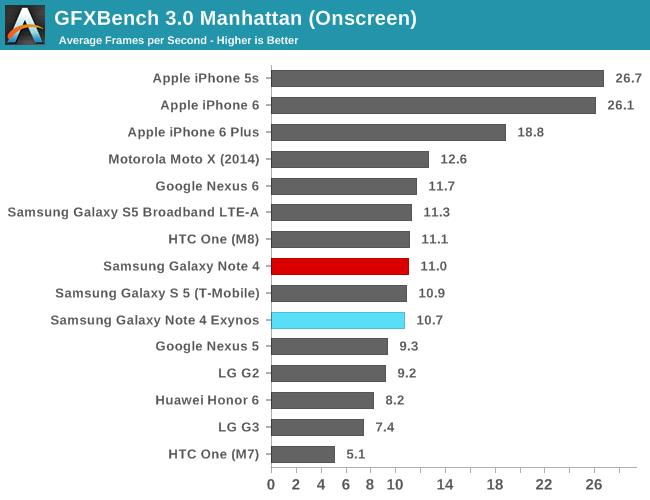
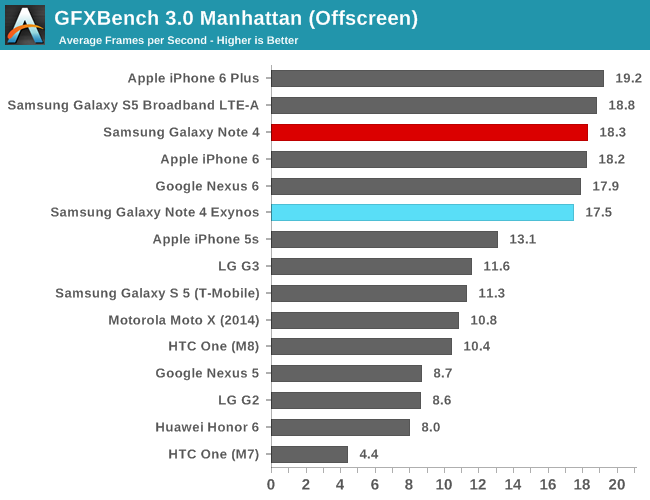
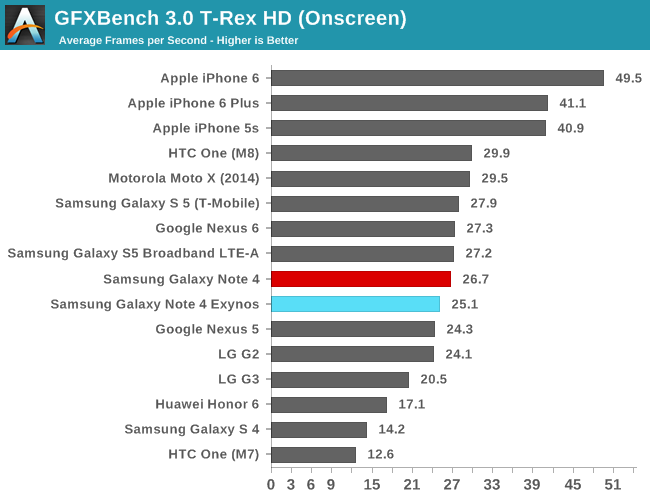
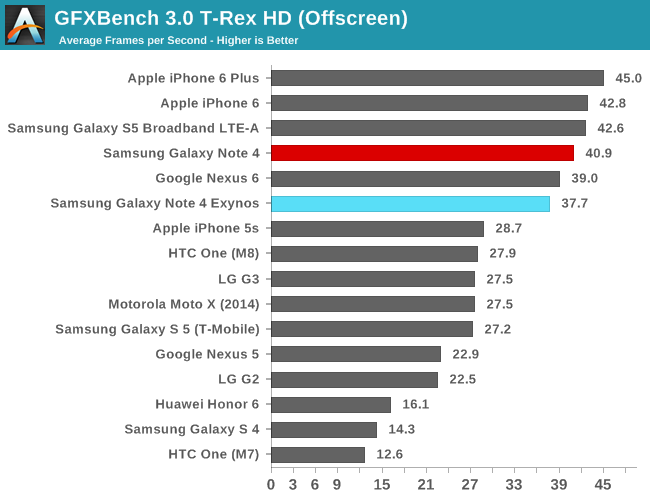
Again we continue to see the same pattern in GFXBench's scenario benchmarks, with the Exynos version lagging a few frames behind the Qualcomm GPU in both Manhattan and T-Rex, in both on-screen and off-screen results.
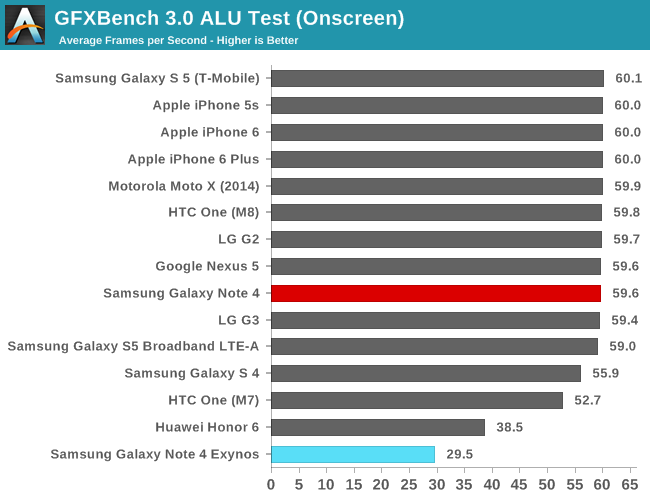

It's on the synthetic tests that we finally see some major deviation between the two architectures. ARM's Mali simply can't seem to keep up with the ALU throughput of Qualcomm's architecture. Both the Adreno 330 and 420 have a clear computational power advantage, exceeding even Imagination's PowerVR GPUs in the iPhones, leaving Mali strictly on the lower end of the performance spectrum.
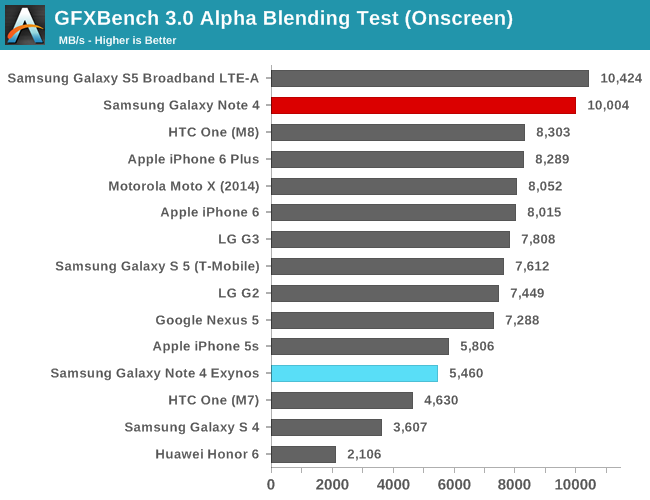
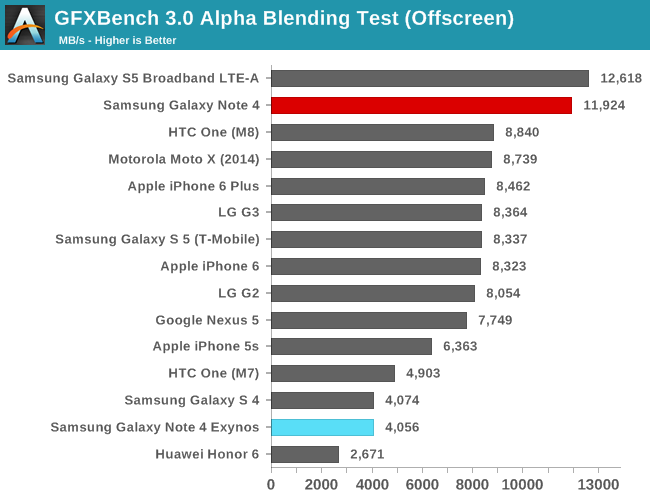
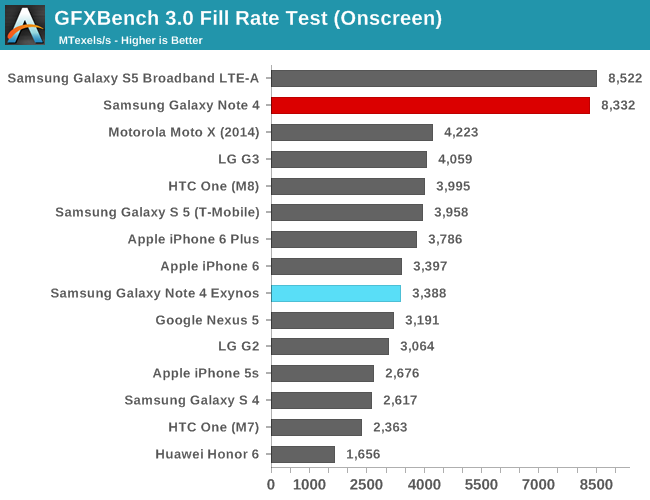
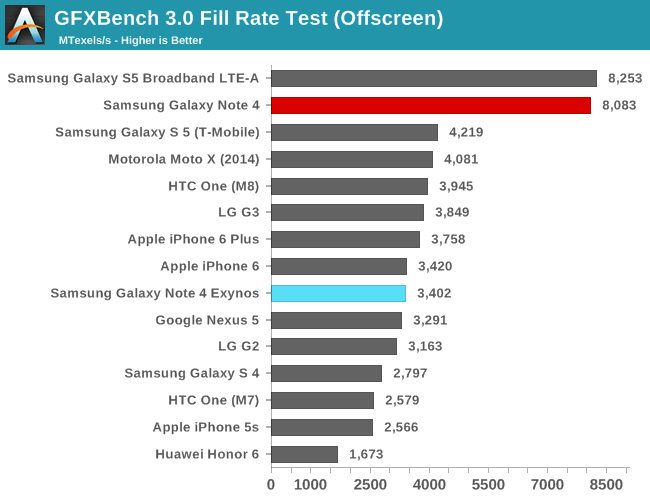
We see a similar situation in the Alpha Blending and Fillrate tests, as the Adreno offers 2-3x the throughput. Utilizing the extra memory bandwidth here seems to be key to the success of the Snapdragon 805's graphics performance.

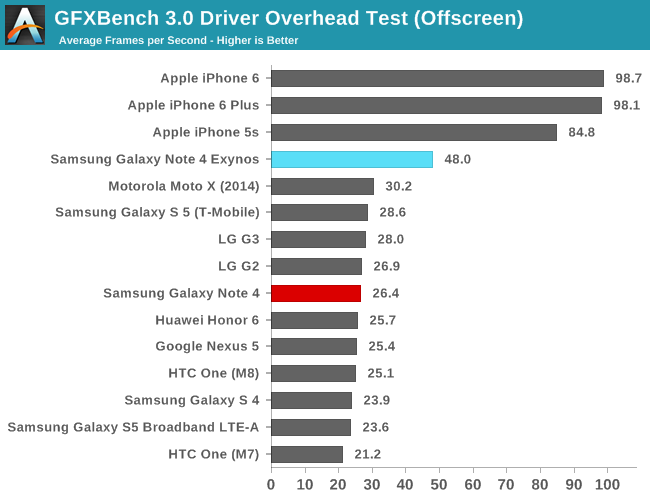
I've already mentioned the Driver Overhead score in the the more in-depth analysis of the T760. It's the first Android device to truly stand out from the rest of the crowd, finally making some progress into trying to catch up with Apple's excellent performance on iOS. Here's hoping more vendors concentrate on improving this metric in future driver updates.
I did some extensive power measurements on the Note 4 Exynos in this review, so naturally we're keen to see how this transforms into our battery benchmarks on the next page.










135 Comments
View All Comments
habbakuk87 - Wednesday, February 11, 2015 - link
I had like to thanks the writers for great in depth article, this is the kind of thing which has kept me coming to this site over the past many years.Keep up the good work.
Arbie - Wednesday, February 11, 2015 - link
Yes, this is a great article - knowledgeable and in-depth. Work like this is what keeps Anandtech way above the crowd. Thanks.joe_dude - Wednesday, February 11, 2015 - link
What it looks like to me is that they need to cap 4 big core load to 1.6 GHz, which would keep the thermals under control. Going by the chart, 1 core @ 1.9 GHz, 2 cores @ 1.8 GHz, 3 cores @ 1.7 GHz would work nicely for power consumption/heat as well. It seems Samsung and Qualcomm are setting the max frequency too high. That last 100 to 200 MHz requires a lot more voltage.joe_dude - Wednesday, February 11, 2015 - link
You look at the power consumption at 1.9 GHz vs. 1.6 GHz - 7.39w vs. 4.44w. That's the crux of the problem right there. 4 cores should not be running at such a high clock speed (and voltage needed to support it).PrinceGaz - Wednesday, February 11, 2015 - link
"So the question is, is it still worth to try and get an Exynos variant over the Snapdragon one? I definitely think so. In everyday usage the Exynos variant is faster. The small battery disadvantage is more than outweighed by the increased performance of the new ARM cores."That made me laugh as it is easily the most out of touch comment I've read in an AnandTech review.
It may be true for you as a reviewer sitting at home with the phone plugged into a USB charger running benchmarks that you feel the extra performance is worthwhile, but it will count for nothing when you use it in the real world and find your battery is dead earlier. Almost everyone with a smartphone today would rather have longer battery life instead of higher performance, because just like with PCs for some time now, the performance is already good enough.
Longer battery life trumps extra performance in smartphones now. I don't know why you want to put a positive spin on these higher performance but lower efficiency A57/A53 cores; I doubt ARM are paying you, but it seems they are a step backwards for people who use their phone primarily on the move, which includes most people.
patrickjchase - Wednesday, February 11, 2015 - link
From long experience with a variety of microarchitectures (including ARMs), I would guess that the latency/bandwidth "oddities" reflect differences in hardware prefetch. That's the most logical culprit among the list of changes that ARM provided.The hypothesis that the capability to dual-issue loads/stores impacts bandwidth to L2 and/or DDR seems questionable, because 4xA7 already has enough ld/st bandwidth to saturate both. Memory-limited code shouldn't see much impact due to issue-rule relaxation.
aryonoco - Wednesday, February 11, 2015 - link
Andrei and Ryan, thank you. I have not been impressed with anything Anandtech has published this much since the Original HTC One M7 review by Brian.I believe you guys have just published the most thorough, detailed, comprehensive review of every aspect of an ARM SoC. Short of working at a chip maker's lab, I don't think anyone is going to have any better exposure to the ARM ecosystem than what you guys have presented here.
Huge thanks for finally paying attention to the SoCs that don't make it to the North American market. I've been fascinated by their performance and power consumption metrics, it's great to finally have an authoritative view of them. I would love to have your take on some other SoCs in this regard as well, especially Cortex A17. There is not much coverage of Cortex A17 and I think, given the situation with big.LITTLE, a quad core well optimised Cortex A17 might actually be a hidden weapon that no one seems to be using.
Also very much looking forward to your coverage of overclocking/undervolting mobile devices. You guys are truly bringing AnandTech to the mobile industry.
Once again, thank you. To be honest, I've been a bit worried since Anand and Brian's departure about the direction of AT, and it's so good to see it thrive in such capable hands now.
Andrei Frumusanu - Wednesday, February 11, 2015 - link
I'm planning on reviewing the A17, but still in the process of securing a device. Hopefully in the near future.aryonoco - Wednesday, February 11, 2015 - link
On the subject of Javascript benchmarks and Chrome vs Stock browsers:Are we sure that all of the difference is indeed due to the optimized libraries that Samsung has developed, and that there is no benchmark-targeting optimization going on? After all, we saw what happend with Sunspider (and thanks for dropping it), it is impossible that they are not targeting Kraken and Octane as well?
Would it be feasible for Anandtech to develop its own proprietary javascript benchmark? It could answer a few of these questions.
tuxRoller - Wednesday, February 11, 2015 - link
This was an excellent read.Good detail, and enlightening investigation.
With regards to the power aware governor, you have to realize that it's a very hard problem. One that no one has managed, yet (iirc, huawei has claimed that their kernel has such a scheduler, but, you've seen how well it works), for general loads. Yes, there are many ideas but, as you've surmised, board implementations can drastically change assumptions.
BTW, power collapse appears to just be the arm term for the state under which cpuidle takes over for that core. So, it's not actually powered off, thus hotplug would still be needed.
For an overview of the domain see: http://lwn.net/Articles/482344/
Some useful links:
https://rt.wiki.kernel.org/index.php/Energy_Aware_...
https://lkml.org/lkml/2014/5/23/621